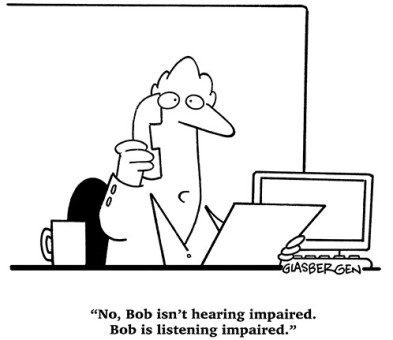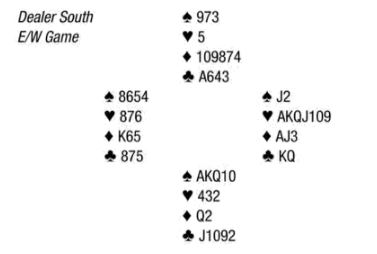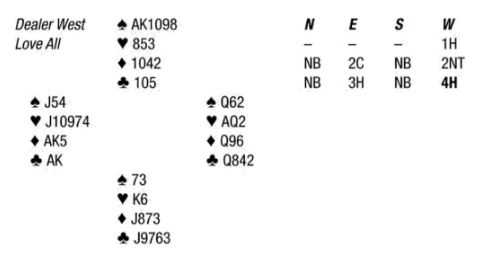Source:
121 Tips for Better Bridge By Paul Mendelson

51 / LISTEN TO WHAT YOUR OPPONENTS HAVE BID AND COUNT THE HAND
When dummy hits baize. do as the experts do — take your time. Form an overview of the situation so that you will be ready to face the challenges as they arise. Count your winners or loser (see Tip 61) and analyse the lead (see Tips 53-5). If either opponent has bid, remind yourself of the auction and, importantly, add up your combined point-count, and work out how many points your opposition hold. You will be surprised at how often you are able to place the remaining cards, either immediately, or quite shortly into the play of the hand. An opening bid of 1 NT is particularly revealing, disclosing as it does a balanced distribution and an exact point-count. This deal illustrates the value of remembering the auction, and counting the hand:

Because N/S were playing transfers, North had to pass 1NT (rather than making a Weak Take-out). East doubled, hoping to extract a sizeable penalty but. when North ran to 2

, he decided to have a punt at 4

. South led

A, and declarer took stock He had three certain losers: two spades, and

A. The contract therefore depends on not losing a diamond. An unthinking declarer takes the diamond finesse through North — the only way he could finesse — and, anyway, North bid diamonds. Such an unthinking effort would receive its Just result. Instead take pleasure from detection and deduction . South cashes

AK. and continues with

Q. East trumps this, and pulls trumps. He now plays

K and, when this loses to North’s

A, he knows the whole picture. E/W hold 24pts between them, leaving N/S with 16pts. South must hold 12pts for his 1NT opener, so North’s

A is his only card of value.

Q is unquestionably with South. As no finesse position exists, when North correctly returns a club, East should cash

AK, and play for

Q to drop. It does — and you have brought home an lunmakable’ contract. Don’t, whatever you do. lead

J thinking this is a finesse. South merely covers this with his

Q and, once

K is played, and A+ cashed, you are left with a small diamond in each hand. You can only lead a high card for a finesse if you (or dummy) hold the card beneath it. If. on the hand above. South had shown up with

A as well as his

AKO. you would then have known that North holds

Q. He must do. for South has shown 13pts, and cannot hold a further 2pts and still have opened a Weak NT (12— 14pts).
52 / LISTEN TO WHAT YOUR OPPONENTS HAVE NOT BID AND COUNT THE HAND
For all the reasons we have seen in the previous tip, you should be alert to inferences you can take from an uncontested auction — although they are often much harder to spot. An old friend of mine, Adrian Palmer, spotted the right line on this hand only just in time, when we were playing in the Sobranie Championship Final many years ago:

Adrian opened 1

and, after his NT rebid. I doubtfully showed him three-card support. He raised to 4

which, since 3NT failed at the other table, was a smart move. North led

AK. and then a third spade, which South ruffed with 6

. South then exited with

3. The contract now depends upon not losing a trump trick and it seemed to Adrian, just as it would to any of us, that the heart finesse was the only available play. However, as I watched, feigning disinterest, Adrian led

J and opened his mouth to call for a card from dummy. At this point he stopped. As he explained to me later, it suddenly occurred to him that North had started with

AK1098 and that, had he held

K as well, he would certainly have overcalled 1

. As the North player had appeared anything but backward in the bidding on the previous hands. Adrian now placed

K with South and called for

A from dummy. The

K fell politely. At the time, we were at the top table, and there were several kibitzers watch-ing South. one of whom was British International Jeremy Flint. The kibitzers seemed to think Adrian’s play was suspect … Had he seen his opponent’s hand? Jeremy Flint merely nodded at him, said. ‘Quite right.’ and started jotting down the hand for his newspaper column.
 51 / LISTEN TO WHAT YOUR OPPONENTS HAVE BID AND COUNT THE HAND
When dummy hits baize. do as the experts do — take your time. Form an overview of the situation so that you will be ready to face the challenges as they arise. Count your winners or loser (see Tip 61) and analyse the lead (see Tips 53-5). If either opponent has bid, remind yourself of the auction and, importantly, add up your combined point-count, and work out how many points your opposition hold. You will be surprised at how often you are able to place the remaining cards, either immediately, or quite shortly into the play of the hand. An opening bid of 1 NT is particularly revealing, disclosing as it does a balanced distribution and an exact point-count. This deal illustrates the value of remembering the auction, and counting the hand:
51 / LISTEN TO WHAT YOUR OPPONENTS HAVE BID AND COUNT THE HAND
When dummy hits baize. do as the experts do — take your time. Form an overview of the situation so that you will be ready to face the challenges as they arise. Count your winners or loser (see Tip 61) and analyse the lead (see Tips 53-5). If either opponent has bid, remind yourself of the auction and, importantly, add up your combined point-count, and work out how many points your opposition hold. You will be surprised at how often you are able to place the remaining cards, either immediately, or quite shortly into the play of the hand. An opening bid of 1 NT is particularly revealing, disclosing as it does a balanced distribution and an exact point-count. This deal illustrates the value of remembering the auction, and counting the hand:
 Because N/S were playing transfers, North had to pass 1NT (rather than making a Weak Take-out). East doubled, hoping to extract a sizeable penalty but. when North ran to 2
Because N/S were playing transfers, North had to pass 1NT (rather than making a Weak Take-out). East doubled, hoping to extract a sizeable penalty but. when North ran to 2 Adrian opened 1
Adrian opened 1
























